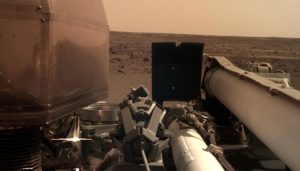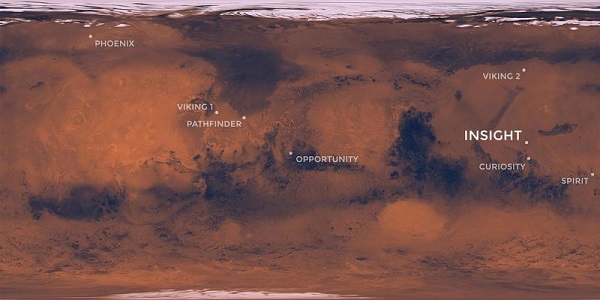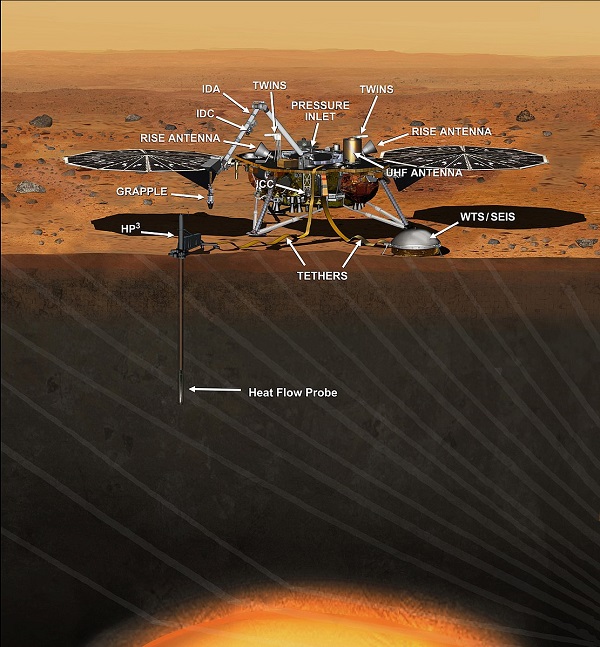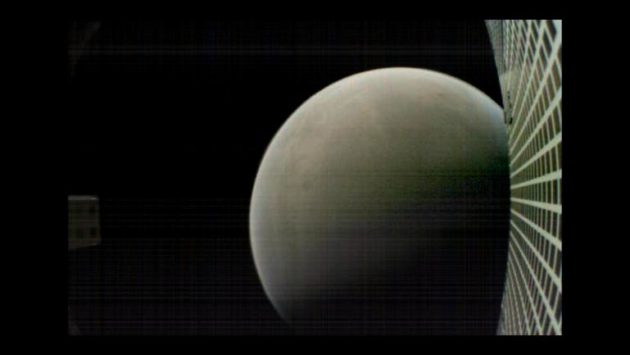After a safe landing, NASA's first dedicated geophysical mission to Mars will spend the next two years studying the deep interior of the Red Planet.

NASA / JPL-Caltech
After “seven minutes of terror,” and a seven-month journey of almost 300 million miles (500 million kilometers), NASA's Mars Insight (Interior Exploration using Seismic Investigations, Geodesy and Heat Transport) lander went from over 12,000 mph to zero, for NASA's eighth successful landing on the Red Planet.
“This accomplishment represents the ingenuity of America and our international partners and it serves as a testament to the dedication and perseverance of our team,” said NASA Administrator Jim Bridenstine in a November 26th press release.
The landing went flawlessly on the Elysium Planitia region of Mars, 370 miles (600 kilometers) north of Gale Crater, the stomping grounds of NASA's Curiosity rover. The landing occurred on Monday, November 26, 2018 at 2:52:59 PM EST (19:52:59 Universal Time). Insight phoned home from just over eight light-minutes distant and relayed its safe touchdown on Mars via the Deep Space Network, much to the elation of scientists and engineers on Earth.
The criterion for the landing site was a flat, featureless and perhaps visually boring region. This was not only an ideal site from a safety and engineering perspective, but also a great location for what Insight is designed to do. Insight needed an equatorial site for optimal solar panel function, low elevation for entry and descent — giving it a slightly thicker cushion of tenuous atmosphere — and a site relatively free of boulders for a safe landing, along with a softer surface for drilling operations.
Landing also occurred during the tail end of the 2018 dust storm season, a potential concern that arose during Insight's transit to Mars, but did not affect landing operations.

NASA / JPL-Caltech
Just over two and a half hours after landing, both solar panels on the lander deployed correctly, another essential early mission milestone. The panels will provide the spacecraft with 600 to 700 watts, enough to power a kitchen blender. Even coated with dust — a common occurrence for spacecraft on Mars — Insight's panels are expected to generate 200 to 300 watts, enough for science operations.
“The Insight team can rest a little easier tonight now that we know the spacecraft solar arrays are deployed and recharging the batteries,” said Tom Hoffman (JPL). “Tomorrow begins an exciting new chapter for Insight: surface operations and the beginning of the instrument deployment phase.”

NASA / Bill Ingalls
Insight Science
Insight will chronicle "Mars-quakes" and geologic activity and will also drill into the surface of Mars in an effort to probe its interior.
The primary mission for Insight is set for two years, or one Martian year. Insight will also will be able to detect the tug of the Martian moon Phobos as the satellite gently raises the ground about 0.6 inches (1.5 cm) when it passes overhead about once every 11 hours, another natural tool that can be used to probe the planet's interior. Insight will also record the seismic vibrations from meteor strikes, and it's conceivable that imagery from the Mars Reconnaissance Orbiter could match these detections to fresh impact craters.
Insight marks a departure from past missions that were jack-of-all-trades platforms. Instead, Insight specializes in addressing specific questions about Mars: How similar (or different) is the interior of Mars versus other rocky planets? How does the interior of the planet affect what we see on the surface? What is the structural thickness of the crust and the size and density of the core? What is the planet's current rate of heat loss?

NASA / JPL-Caltech
Meet the Science Instruments
Insight carries three major instrument packages.
The Seismic Experiment for Interior Structure (SEIS): A deployable dome-shaped package meant to monitor internal activity on Mars, SEIS was provided by the French Space Agency along with the Swiss Federal Institute of Technology, the Imperial College, the Max Planck Institute for Solar System Research, and JPL. The package sits inside a protective dome, isolating it from wind vibrations that plagued the Viking 2 seismometer.
The Heat Flow and Physical Properties Package (HP3): Known affectionately as "the mole", this package will work on a tether and drill to 16 feet (4.9 meters) below the surface as it measures the heat dissipation from the core of Mars.
Rotation and Interior Structure Experiment (RISE): Built by JPL, RISE will use X-band radio signals to precisely measure the minute wobble in the rotation of Mars, building on data provided by the Pathfinder and Viking missions.

NASA / JPL-Caltech
The lander also carries several other science instruments.
Temperature and Winds for Insight (TWINS): The weather station aboard Insight, TWINS was built by the Center for Astrobiology in Spain. TWINS will also be the first continuous weather monitor on Mars and will eventually provide a daily weather forecast for Elysium Planitia.
The Laser Retroreflector for Insight (LaRRI): A corner cube reflector, this will function as a passive geophysical node, allowing future laser altimeter spacecraft missions in orbit to bounce laser signals off of it and precisely measure its location. Built by the Italian Space agency, a copy of the reflector flew on the European Space Agency's failed Schiaparelli lander in 2016. These reflectors will still be useful after Insight has fallen silent, allowing the lander to continue chronicling movement of the surface of Mars.
The lander also comes equipped with a robotic deployment arm, a main instrument camera and panoramic context cameras, both of which are duplicates of the same cameras used on Curiosity. Insight also carries two small silicon chips encoded with the names of about 2.4 million people.
Trail-Blazing Mars CubeSats
The MarCO-A and MarCO-B cubesats, named Eva and Wall-E, also performed their jobs during Insight's landing, relaying telemetry from the lander as they flew 2,200 miles (3,500 kilometers) past Mars, another first.
“That's one giant leap for our intrepid, briefcase-sized robotic explorers,” said Joel Krajewski (JPL). “I think CubeSats have a big future beyond Earth's orbit, and the MarCO team is happy to trail-blaze the way.”
Insight's successful landing was not exclusively dependent on MarCO satellite relays, but they managed to complete the first transmission three hours ahead of the Mars Reconnaissance Orbiter and Mars Odyssey, proving that a mission can bring its own satellite relay along for the ride. This is also a handy proof of concept for planned missions to Europa and Titan, where no orbital relay network exists.

NASA / JPL-Caltech
What's Next for Insight
Now that Insight is safely on the Martian surface, the first step is reconnaissance. Scientists will spend three weeks scouting out the landing site using the main camera, while the weather station starts measuring conditions at the site.
First up, Insight will deploy its 5.9-foot-long (1.8-meter) robotic arm over the next two days, and begin to survey the landscape around the lander. Researchers will then select a location to deploy the surface experiments. Insight will use its robotic arm to grab and place the SEIS, its protective cover, and the HP3 package on the surface. This is a slow process, and should be completed in early 2019, about 10 weeks after landing.
Then, the HP3 "mole" will begin hammering away, digging into the surface of Mars about 1 millimeter at a time. SEIS should detect this activity, and will use these taps to map the Martian crust directly under the lander. The mole will also stop after every 20 inches (50 cm) of digging to take a measurement of the heat flow from the Martian interior. This will also be a slow process, as the mole will have to pause for about four days between drilling sessions to allow heat from its own activity to dissipate.
The mole will hammer at the Martian soil an estimated 5,000 to 20,000 times en route to its five-meter target depth. The entire digging process is expected to take anywhere from 30 to 40 days, and the mole must achieve a depth of at least 3 meters for good science results.
Then, Insight must sit silent to take delicate seismic measurements. To this end, the lander isn't even equipped with a steerable radio dish or anything that could induce vibrations in the deployed detector. Instead, Insight has fixed opposing horn antennas for communication.
Get set for some fascinating science as NASA's first dedicated geophysical laboratory on another planet gets down to business.
Editor's Note: This post was updated on November 29th to add an image of Mars taken by the MarCO-B cubesat. Updated on December 3rd to correct the units used to describe the power output of the lander's solar panels.
 9
9









Comments
Roger-Keith
December 1, 2018 at 12:47 am
Since dust on solar cells seems to be a chronic problem, why don't landers also carry something to remove the dust? Maybe a windshield wiper or a rotating brush could do the trick.
You must be logged in to post a comment.
David DickinsonPost Author
December 1, 2018 at 1:19 am
Not a bad idea... though in the case of Insight, the vibrations would hamper data collection. I know Oppy and Spirit relied on the Martian wind to occasionally wipe them clean.
You must be logged in to post a comment.
BobW
December 1, 2018 at 3:05 pm
Great news, but there is an inaccuracy in the report: It says "The panels will provide the spacecraft with 600 to 700 watts per day, enough to power a kitchen blender." But "watts per day" is not a unit of power. The panels might produce 600 to 700 watts, let's assume it is at the moment getting enough light to do that. If that happens for an hour, that will come to 600 to 700 watt-hours of power. If it happens for longer or shorter time, the amount of power changes accordingly. Watts tell us how fast power is being generated, not an amount of power.
The comparison to the kitchen blender is OK: The label on the blender will be in watts (or an equivalent unit) telling how fast it uses power. If you run it for a longer time you use more power.
This is pretty much the same error as using "light year" as a unit for time or velocity rather than distance. It is also a common error in dealing with the bill from your power company: They should be charging you for "kilowatt hours", not "kilowatts".
Sorry to nit-pick, but the rest of the article is so nice that it deserves to tell the truth!
Bob W
You must be logged in to post a comment.
Christopher Crockett
December 3, 2018 at 1:44 pm
You're absolutely right. That should be just watts, not watts per day. We've updated the post. Thank you for the note! -- Sky&Tel acting News Editor
You must be logged in to post a comment.
AB
December 3, 2018 at 11:34 pm
Cool. Looking forward to updates.
"...the tug of the Martian moon Phobos as the satellite gently raises the ground about 0.6 inches (1.5 cm) when it passes overhead about once every 11 hours,..."
How much does our moon raise Earth's surface?
You must be logged in to post a comment.
David DickinsonPost Author
December 4, 2018 at 6:17 am
Earth's Moon is much larger... but much farther away. Looks like the figure is anywhere from half to several centimetres, depending on the geometry: https://en.wikipedia.org/wiki/Earth_tide#Tidal_constituents
You must be logged in to post a comment.
AB
December 7, 2018 at 12:02 am
Whew, that article could be a lot clearer written for laypeople... but the 'effects' section was interesting, since I'd been following the seismic updates from Kilauea through the eruption.
Thanks for the reply.
You must be logged in to post a comment.
Ben
December 29, 2018 at 12:55 am
Morning ladies and gentlemen.
I have been following Sky and Telescope" since around 2000 and always find the articles very insightful. Today I came across something that tickled my funny bone and after digging around on the internet to confirm some facts that I believe to be true I have a need for some clarification.
"Insight phoned home from just over eight light-minutes distant". I is possible that I completely misunderstand the sentence but; the sun is just over 8 minutes distant. How can mars at a roughly a third of the sun's distance be 8 light minutes away?
Please clarify what I misunderstood?
Regards
Ben (not a rocket scientist)
You must be logged in to post a comment.
David DickinsonPost Author
December 31, 2018 at 10:53 am
Hi Ben,
Mars is indeed roughly a third of the Sun's distance from the Earth... when it's at opposition. Mars can range from 54.6 million to 225 million kilometers from the Earth when its at solar conjunction, on the far side of the Sun.
You must be logged in to post a comment.
You must be logged in to post a comment.